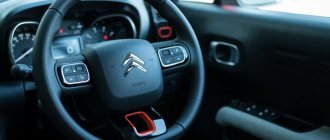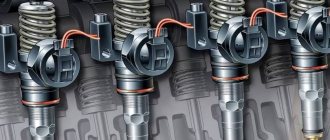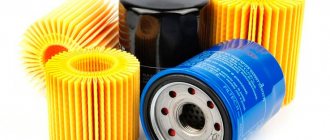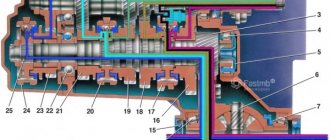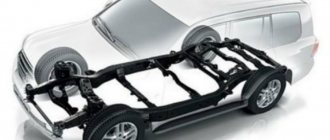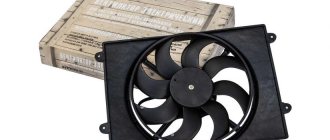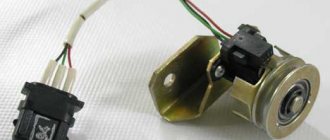A driveshaft is a device for transmitting torque from a gearbox or transfer case to the rear wheels.
Widely used on rear-wheel drive and all-wheel drive vehicles from the beginning of the twentieth century to the present. The cardan transmission device was first described in the 16th century, but the creation of the device in practice occurred much later.
Cardan shaft device
The cardan transmission diagram includes the following elements:
- One or more sections of thin-walled hollow pipe;
- Splined sliding connection;
- Forks;
- Crosspiece;
- Suspension bearing;
- Fastening elements;
- Rear movable flange.
The unit itself can be single-shaft or double-shaft.
In the second case, the mechanism includes an intermediate cardan shaft, to the rear section of which a shank with external splines is welded, and a sliding sleeve is fixed to the front section through a hinge. Single-shaft systems do not have an intermediate section. At the front of the car, the unit is fixed in the gearbox using a movable spline connection (a movable coupling of the front part of the propeller shaft). To do this, there is a hole with internal slots at the end of the mechanism. The driveshaft design implies the possibility of longitudinal displacement of the splines when the vehicle is moving.
Next, the driveshaft suspension bearing is installed, which is attached to the body through a bracket. This serves as an additional fastening of the unit, preventing its excessive displacement when driving.
Next comes the driveshaft fork, which is located between the front and middle parts. A cross is installed here, on which there are needle bearings. The presence of forks and a cross makes it possible to transmit torque at different bending angles of the “cardan”.
At the rear, the transmission is attached to the rear axle gearbox via a flange. In this case, the shank, equipped with external splines, fits into the flange of the main gear drive.
Useful tips
Remember that you should never ignore any signs of a cardan malfunction. If you do not heed this advice, you may experience the following consequences:
- If the cardan breaks, the vehicle body itself is damaged. Additionally, the cardan can damage the pipeline that runs along the bottom of the car.
- If constant vibrations are observed, this will negatively affect the rigidity of the suspension and body mounts. All threaded connections and fastenings of interior panels will also begin to loosen. The car will literally begin to fall apart while driving.
- All parts directly connected to the driveshaft will wear out faster and more intensely. This will significantly shorten their service life and require early replacement and expensive repairs.
It is unlikely that any car owner will consciously want to face such troubles.
But in many ways they can be avoided if you follow a few simple rules. All these recommendations are aimed at increasing the service life of the driveshaft.
If you are interested in preserving the HF resource, then you need to:
- try to minimize vehicle operation in rough terrain;
- do not accelerate sharply;
- move away smoothly;
- do not skid the car for a long time;
- do not skimp on quality spare parts;
- carry out diagnostic measures;
- If complex faults occur, contact qualified technicians.
The driveshaft is in many ways an important element of a vehicle, which, although considered an intermediate link, plays a key role in the operation of rear-wheel drive and all-wheel drive vehicles.
The unit does not have an extremely complex structure, and its operating principle is clear to many. This allows you to independently solve problems that arise, detect faults in a timely manner and maintain the HF in working order for a long period of time, simply by following a few simple rules.
Operating principle of HF
The principle of operation of the cardan transmission is the ability to transport torque when the position of the “cardan” in space changes. This principle is implemented through two mechanisms:
- Sliding fork of the cardan shaft;
- Cross joint.
A sliding fork is necessary to slightly increase the length of the mechanism when driving on uneven roads. Due to the long spline connection, the supply of torque does not stop when the suspension, together with the rear axle, moves up or down.
The hinge, in turn, ensures rotation of the wheels when the bending angle of the CV changes. It is believed that the mechanism is capable of working productively at angles of no more than 20°. Then its active wear begins.
Types of cardan drives
In the modern automotive industry, the following types of cardan transmissions can be used:
- Equipped with a unequal velocity joint (classic car driveline);
- Equipped with CV joints (constant velocity joints);
- Equipped with semi-cardan elastic joints;
- Equipped with rigid semi-cardan joints.
The system with the NUS hinge is considered classic. There are forks, crosspieces, and needle bearings. Suitable for most rear wheel drive vehicles.
Modern SUVs often use a system equipped with CV joints. Such devices provide more comfortable driving conditions, almost completely eliminating vibrations.
Elastic hinges are a rubber coupling capable of transmitting torque at bends of no more than 8°. The rubber is quite soft, so a shaft with a similar structure ensures a smooth start of movement and the absence of sudden dynamic loads. In addition, flexible connections require no maintenance. The rigid semi-cardan joint has a complex technical device and transmits torque due to gaps in the spline connection. Due to the complexity of manufacturing, technical shortcomings and rapid wear, it is not used in the automotive industry.
ADVANTAGES
The advantages of cardan transmission include:
- Work with significant torques.
- Possibility of connecting transmission units installed at large distances from each other.
- Implementation of all-wheel drive on a car.
- Simplicity of design.
- Resistance to loads.
But at the same time, the cardan increases the metal consumption of the transmission and requires significant space for installation, which affects the usable volume of the cabin.
Cardans with unequal velocity joints do not require maintenance and at the same time have a significant service life. Despite the use of bearings in the design, there is no need to lubricate them during operation, since the joint itself is maintenance-free, and the lubricant supplied by the manufacturer is enough for the entire service life.
The cardan is a non-repairable unit. When bent, the cardan requires complete replacement. This is due to the fact that the unit is balanced during manufacturing. Bends lead to imbalance, which increases vibrations and loads in the gearbox and final drive and accelerates wear of the joints.
The hinges are also not repairable, therefore, if increased vibration appears from the cardan side, or third-party sounds (crunches, clicks), the components of the hinge are replaced. Usually the crosspiece and its bearings are subject to replacement, but if the lugs are very worn out, the assembly assembly is replaced.
[custom_ads_shortcode3]
Frequent malfunctions and their elimination
All malfunctions can be divided according to emerging signs of failure:
- Vibration when moving - the bearings of the cross or the sliding sleeve are worn out, the balancing of the shaft is disrupted;
- Knocks when starting - the sliding joint splines are worn out, the fastening bolts are loose;
- Oil leakage from the bearings means wear of the seals.
To eliminate the problems described above, the “cardans” are dismantled and defective, and faulty parts are replaced. If there is an imbalance, the shaft must be balanced under dynamic conditions.
Prospects for the development of a cardan transmission system
The classic ShNUS has some technological disadvantages. The rotation speed of its shafts changes during movement. In this case, the driven shaft can accelerate and decelerate at a stable speed of the drive shaft. This leads to accelerated wear of the mechanism and also creates excess load on the rear axle. Also, the operation of the hinge is accompanied by vibration. The purpose of the cardan drive can be performed by a shaft equipped with CV joints (front and rear). Similar systems are already used on some SUVs today. Also, the cardan transmission of the VAZ-2107 and other “classics” can be equipped with a CV joint. Repair kits are available for sale.
The use of a constant velocity joint eliminates the disadvantages inherent in the classic cross. The shaft rotation speed is leveled out, vibration disappears, the HF does not require balancing after repair, and the torque transmission angle increases to 17°.
Where else are cardan-type shafts used?
What is a driveshaft used for, other than connecting the gearbox to the axle and wheels? In reality, the scope of application of NUS hinges is quite large. They are used to create adjustable steering columns, where it is necessary to transmit torque from the steering wheel to the wheels. Cross joints are also used in tool sets. They allow you to work on bolts that are not in a straight line with the wrench extension.
Today, universal joints, despite their widespread use in many areas of industry, are considered obsolete. CV joints are becoming more and more developed, and crosspieces and forks are slowly becoming a thing of the past.
What else is worth reading
Car muffler device
Four-speed gearbox
Purpose of the lubrication system
How does a manual transmission work?
Hypoid transmission
From a technical point of view
Despite the fact that we previously explained that a cardan shaft is not a cardan coupling (in everyday life it is absolutely ignorant to say so, and it will only confuse the interlocutor), from a technical point of view this is exactly the case
If we take into account the correct definition of a cardan according to the basic principle of its operation and the main element, without which a shaft without a coupling would definitely not be called a cardan, but simply a drive
Cardan joint, crosspiece - all these are synonyms for cardan coupling
photo: cumminsforum.com
This joint is the main connecting element that unites the cardan shafts, that is, the rear and front driveshafts (intermediate and main shaft)
On long-wheelbase vehicles or when it is necessary to deviate part of the cardan from a given plane, this is very important, since only the cardan cross (coupling), being the main element of the movable cardan joint, allows rotation to be transmitted between two misaligned shafts

